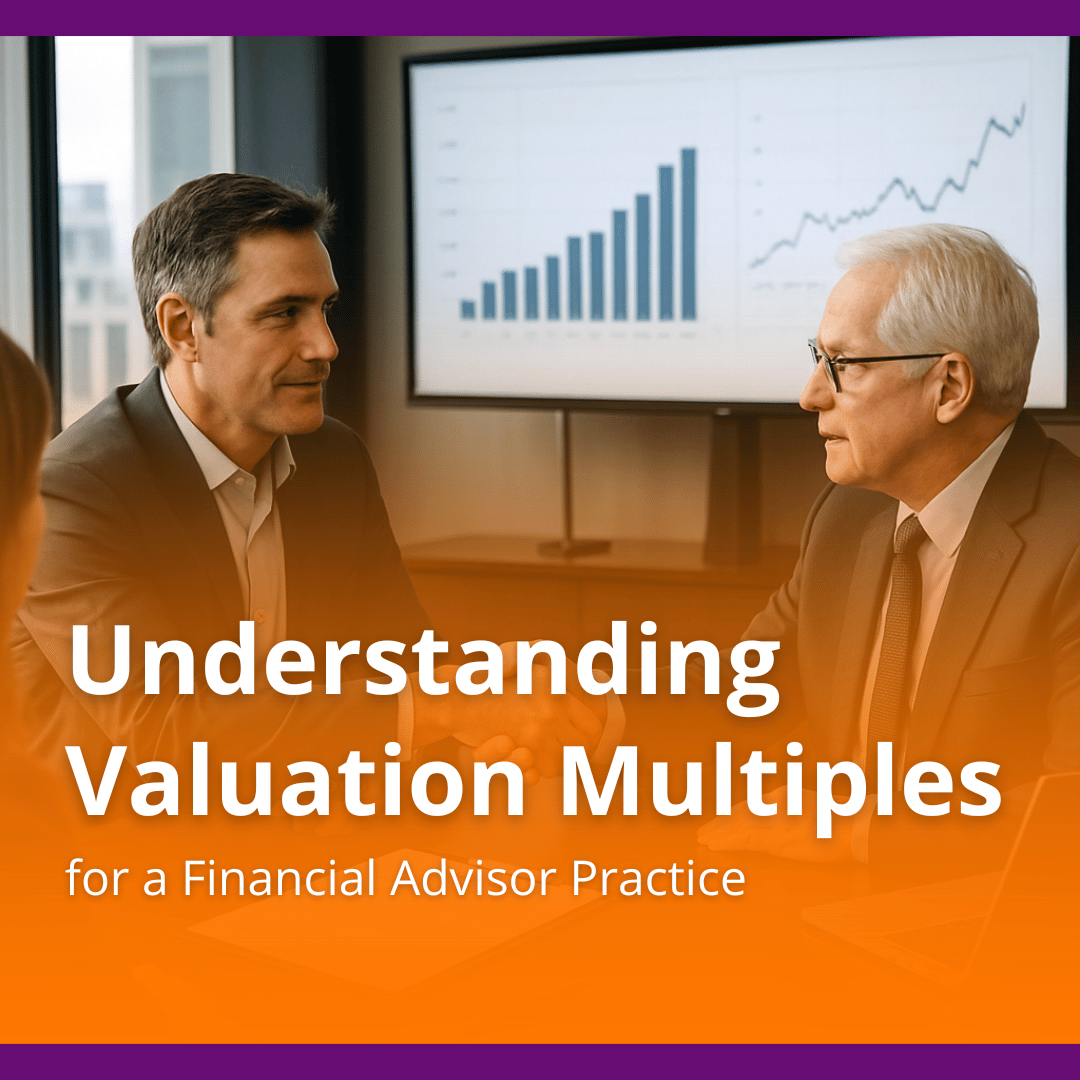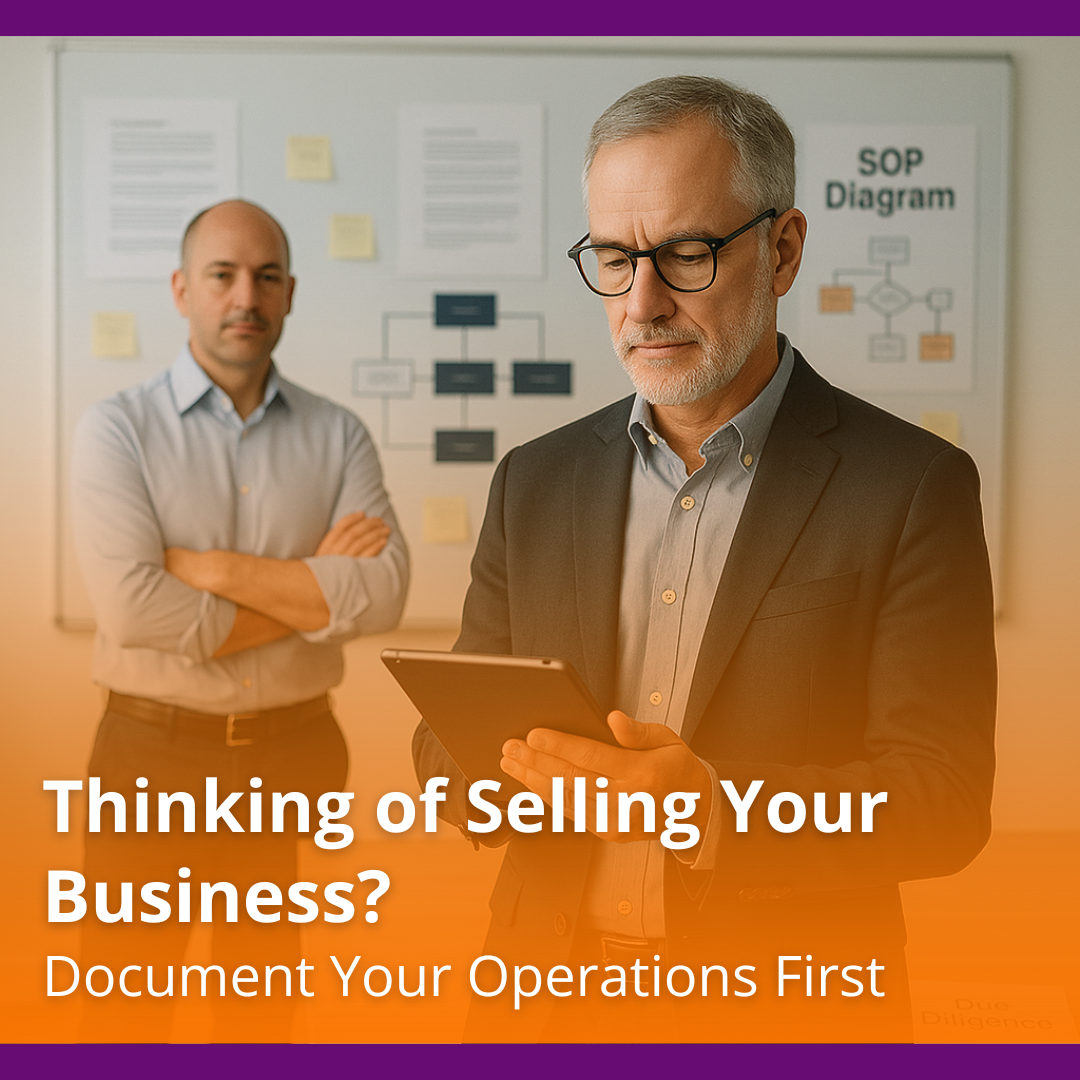Thinking of Selling Your Business? Document Your Operations First
Running a business means knowing every moving part. But to a buyer, that knowledge means nothing if it isn’t documented. And that’s a...
Comprehensive, data-driven valuations and comparative equity analyses to accurately price your practice, establish market benchmarks, and support informed decision-making.
Comprehensive M&A guidance encompassing deal structuring, negotiation strategies, market listings, and transaction closings.
Comprehensive systems, targeted coaching, and in-depth assessments designed to optimize operational efficiency and enhance advisory team effectiveness.
Strengthen continuity through the implementation of formal continuity agreements, the establishment of legal entities, execution of enforceable legal contracts, and securing appropriate capital resources.
6 min read
 Anthony Whitbeck, CFP®, CLU®
July 11, 2025
Anthony Whitbeck, CFP®, CLU®
July 11, 2025

As a financial advisor, you've spent years building your practice and nurturing client relationships. But when it comes time to think about a succession plan or an outright sale, one question looms large: "What is my business actually worth?" The answer often lies in understanding valuation multiples, the industry's shorthand for determining a firm’s value. Yet, many advisors find themselves lost in a sea of jargon, from revenue multiples to EBITDA, unsure of which metric truly reflects their life's work.
At Advisor Legacy, we've guided hundreds of advisors through this exact process. We know that a valuation is more than just a number—it's the culmination of your effort and the foundation for your next chapter. This article will demystify the core concepts of valuation multiples for your advisory practice. We'll break down the crucial differences between revenue and EBITDA multiples, explore how comparable sales are used, and identify the key factors that buyers look for to award a higher multiple.
A valuation multiple is a financial ratio that compares your company’s value to a specific business metric, like revenue or earnings. Think of it as a quick way to gauge your firm's value relative to its financial performance, allowing for a standardized comparison with similar businesses in the market. For financial advisors, these multiples provide a critical starting point for everything from internal succession planning to external M&A discussions.
At the heart of any advisory practice valuation is the book of business—the collection of clients and the assets you manage on their behalf. It represents the recurring revenue streams, client loyalty, and future earnings potential that a buyer is acquiring. The quality, stability, and transferability of these relationships are what give your firm its intrinsic enterprise value.
It's easy to get attached to a specific number, but a multiple is just one tool in the valuation toolkit. The final price is influenced by numerous factors, including deal structure, payment terms, and the strategic fit between buyer and seller. A high multiple with unfavorable terms, like a long and uncertain earnout period, might be less attractive than a slightly lower multiple with more cash upfront.
When valuing a financial advisory firm, the conversation almost always centers on two primary methods: revenue multiples and EBITDA multiples. Each tells a different story about your business, and understanding their nuances is key to grasping your firm's perceived value. A buyer's preference often reveals what they care about most—top-line growth or bottom-line profitability.
A revenue multiple values your practice based on its gross revenue. It's calculated by dividing the enterprise value of a company by its annual revenue. As of August 2025, typical revenue multiples for RIAs can range from 2.0x to over 4.0x, depending on the quality of that revenue. This method's greatest strength is its simplicity, making it a common benchmark in initial conversations.
However, its simplicity is also its biggest weakness. A revenue multiple completely ignores profitability and operational efficiency. A firm could have impressive top-line revenue but be struggling with high overhead, client acquisition costs, and thin margins, making it less valuable than its revenue figure suggests.
EBITDA, which stands for Earnings Before Interest, Taxes, Depreciation, and Amortization, provides a much clearer picture of a firm’s operational cash flow and profitability. An EBITDA multiple is generally considered a more accurate valuation metric because it reflects the business's ability to generate cash. For healthy advisory firms, EBITDA multiples often fall in the 5.0x to 9.0x range, with premium firms commanding even higher figures.
Buyers often prefer the EBITDA multiple because it strips out non-operating expenses and accounting decisions, allowing for a truer comparison between similar businesses. It answers the fundamental question: "How much actual cash is this business generating?" A strong EBITDA margin signals an efficient, well-run practice that is highly attractive in the M&A market.
Consider two advisory firms, both generating $1 million in annual revenue.
Both firms had the same revenue, but Firm B is worth twice as much because its profitability is significantly higher. This simple example highlights why focusing solely on a revenue multiple can be misleading and why buyers ultimately care about earnings.
Multiple analyses don't happen in a vacuum. To determine an appropriate multiple for your practice, financial experts rely on "comps"—data from recent sales of comparable companies. This method provides a real-world benchmark for what the market is willing to pay for a business like yours.
The biggest challenge in using comps is finding businesses that are genuinely similar. An ideal comparable company would match your firm across several dimensions, including AUM, service model (e.g., financial planning vs. investment management), client demographics, and geographic location. Since most advisory firm sales are private, reliable data can be scarce, which is why working with an M&A advisor who has access to proprietary transaction data is invaluable.
No two businesses are identical, so raw multiples must be adjusted to account for differences. Financial statements are often "normalized" to get a clearer view of true earnings. This involves adjusting for one-time expenses, non-recurring revenue, and ensuring the owner's salary is at a market rate.
Beyond firm-level adjustments, recent transaction trends also shape multiples. According to Fidelity, July 2025 deal volumes broke records, with 25 transactions totaling $49.9 billion in purchased assets. Compared to June, transaction volume and purchased assets both surged 39%, underscoring the appetite for scale and the willingness of buyers to deploy significant capital into advisory firm acquisitions.
What separates a practice that sells for a premium multiple from one that gets an average valuation? Buyers are willing to pay more for businesses that are stable, scalable, and have a clear path for future growth. The less risk a buyer perceives, the higher the multiple they will offer.
The most significant value driver is the quality and recurrence of your revenue streams. A practice with 90% fee-based, recurring revenue from long-term clients is far more valuable than one reliant on one-time commissions. High client retention rates and low client concentration (i.e., not having all your eggs in one basket) are clear indicators of a stable, healthy business.
A business that is heavily dependent on its founder is a risky acquisition. To command a higher multiple, your practice must have documented systems and processes that allow it to run smoothly without your constant involvement. A strong supporting team, a modern technology stack, and clear workflows demonstrate that the business is scalable and transferable.
Buyers are purchasing your firm's future, not just its past. A younger client base with significant assets and years of financial growth ahead is highly desirable. Evidence of a consistent ability to attract new clients and a defined marketing strategy also signals strong opportunities for growth, which can significantly increase the enterprise value.
Disorganized financial records or a spotty compliance history are major red flags for any potential buyer. Clean, audited, or reviewed financials instill confidence and streamline the due diligence process. A pristine regulatory record, as detailed by FINRA's compliance guidance, is non-negotiable and essential for maximizing your firm’s value.
Market-level signals also matter. PwC has reported that control premiums in large deals have held steady at roughly 30% over time, which means that the decline in multiples seen in Q2 2025 reflects reduced pricing for larger companies rather than changes in premium levels.
If your goal is to achieve the highest possible valuation, you should begin preparing years in advance. By focusing on strengthening the core drivers of value, you can make your practice significantly more attractive to prospective buyers. A great resource for this journey is our pillar post on selling a financial advisory practice, which covers the process in detail.
Begin documenting all your key operational processes, from client onboarding to investment management protocols. The more you can systematize your practice, the less it depends on you personally. This transition from a "practice" to a "business" is what buyers pay a premium for.
Expand your service offerings to become an indispensable part of your clients' financial lives. Adding services like tax planning or estate coordination can increase your "wallet share" and create stickier relationships. This not only boosts recurring revenue but also improves client retention.
Well before you plan to sell, work with an accountant to clean up your profit and loss statements. Separate personal and business expenses and start tracking key financial metrics. Presenting several years of clean, clear financials makes your business much easier to value and gives buyers confidence in the numbers.
Understanding valuation multiples is the first step toward a successful transition. While a revenue multiple offers a quick gauge and an EBITDA multiple provides a deeper look at profitability, the true value of your business is a blend of quantitative metrics and qualitative strengths. The most valuable advisory firms are those that are not only profitable but are also built on a foundation of stable revenue, efficient operations, and a clear path for future growth.
Selling or transitioning a financial advisory business is rarely straightforward and often calls for specialized guidance. The team at Advisor Legacy helps advisors clearly understand what their practice is worth and identify ways to maximize that value. We provide comprehensive support for practice sales for sellers, ensuring you get the best possible outcome for the business you’ve worked so hard to build. If you’re ready to gain clarity on your firm's value and explore your options, schedule a consultation with Advisor Legacy today.
Anthony "Tony" Whitbeck, CFP®, CLU®, is CEO and Owner of Advisor Legacy. He began his career as a financial advisor in 1989 and later shifted to coaching, where he’s guided more than two hundred advisory practices through growth, valuation, and succession. Tony leads Advisor Legacy’s certified third-party valuation engagements and coordinates lending and legal partners to streamline transactions. His articles focus on building transferable enterprise value, mapping internal vs. external exits, and avoiding common succession pitfalls. Drawing on decades of in-the-trenches experience, Tony provides practical, compliance-friendly guidance advisors can use right away.
Receive timely articles, tip sheets, events, and more right in your inbox.

Running a business means knowing every moving part. But to a buyer, that knowledge means nothing if it isn’t documented. And that’s a...

Growing by acquisition is one of the fastest ways to scale — but it’s also one of the easiest ways to stumble. Behind every successful deal is a...

The M&A landscape in financial services isn’t slowing down. It’s evolving. Fast. As of mid-2025, deal values in the sector have surged by...